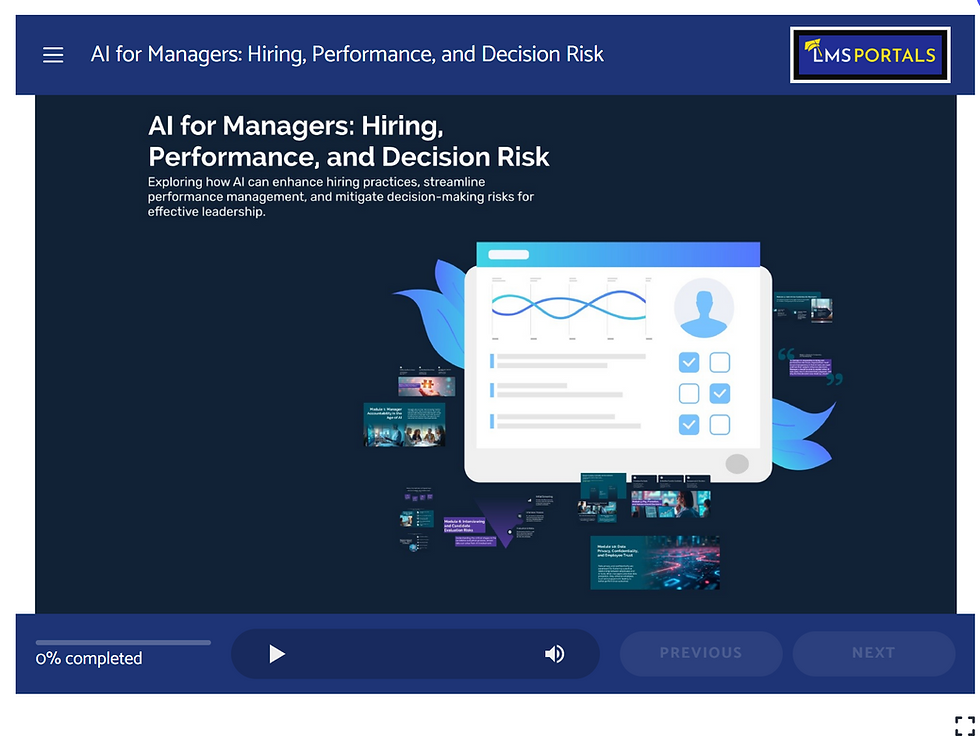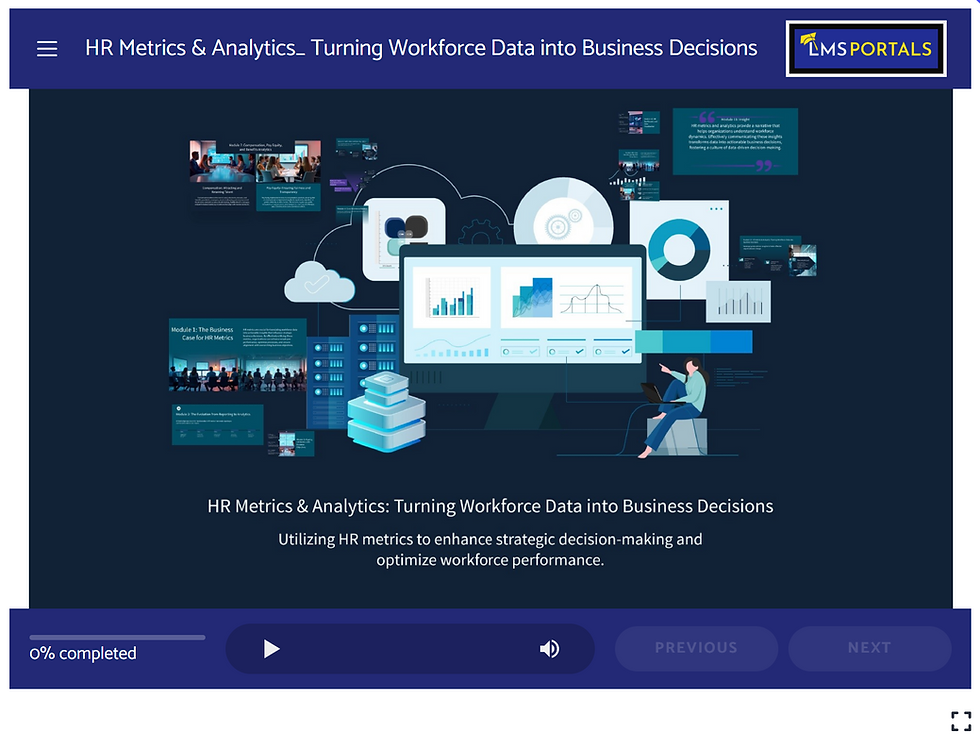Utilizing Technology in HR Training: Best Practices and Tools
- LMSPortals

- Apr 25, 2024
- 4 min read

HR plays a pivotal role in employee training, serving as the architect and facilitator of learning and development initiatives within an organization. Here are the key responsibilities and functions of HR in employee training:
Training Needs Analysis
HR conducts thorough assessments to identify the training needs and requirements of employees and the organization as a whole. This involves analyzing skills gaps, performance deficiencies, emerging job roles, and evolving industry trends to determine training priorities.
Training Strategy Development
HR collaborates with key stakeholders to develop a comprehensive training strategy aligned with the organization's goals, objectives, and culture. This includes defining learning objectives, selecting appropriate training methods and technologies, and establishing performance metrics to measure training effectiveness.
Curriculum Design and Development
HR designs and develops training programs, courses, and materials tailored to address specific learning needs and objectives. This may involve creating in-house training content, leveraging external resources, or partnering with training providers to deliver relevant and engaging learning experiences.
Training Delivery and Facilitation
HR coordinates the delivery and facilitation of training activities, whether conducted in-person, online, or through a blended learning approach. HR professionals may serve as trainers themselves or enlist the expertise of subject matter experts to deliver specialized training sessions.
LMS Management and Administration
HR manages learning management systems (LMS) or training platforms to organize, deliver, and track training activities. This involves overseeing course enrollment, tracking employee progress, generating reports, and ensuring compliance with regulatory requirements.
Employee Onboarding and Orientation
HR designs and implements onboarding and orientation programs to welcome new employees and facilitate their integration into the organization. This includes providing information on company policies, culture, job responsibilities, and initial training to equip employees for success in their roles.
Performance Support and Coaching
HR provides ongoing support and coaching to employees to reinforce learning and development efforts. This may involve offering resources, job aids, mentoring, or coaching sessions to help employees apply newly acquired knowledge and skills in their daily work.
Feedback and Evaluation
HR gathers feedback from employees, trainers, and stakeholders to evaluate the effectiveness of training programs. This includes conducting surveys, assessments, and performance reviews to measure learning outcomes, identify areas for improvement, and make data-driven decisions to enhance future training initiatives.
Compliance and Regulatory Training
HR ensures that employees receive training on compliance-related topics, such as workplace safety, diversity and inclusion, harassment prevention, and regulatory requirements specific to their roles and industries. This helps mitigate risks and maintain legal and ethical standards within the organization.
Continuous Learning and Development
HR fosters a culture of continuous learning and development by promoting ongoing training opportunities, professional certifications, and career development initiatives. This encourages employees to stay engaged, motivated, and proactive in enhancing their skills and advancing their careers.
Overall, HR plays a central role in employee training by identifying learning needs, designing and delivering training programs, supporting performance improvement, evaluating training effectiveness, and fostering a culture of learning and development within the organization.
Utilizing Technology in HR Training: Best Practices and Tools
Incorporating technology into HR training can significantly enhance learning outcomes and streamline the training process. Here are some best practices and tools to consider:
Learning Management Systems (LMS)
Implement an LMS to deliver, track, and manage training programs effectively. Platforms like LMS Portals, Moodle, or Cornerstone OnDemand offer features such as course creation, assessment tools, and reporting capabilities.
Virtual Reality (VR) and Augmented Reality (AR)
Utilize VR and AR for immersive training experiences, especially for scenarios that are difficult to simulate in real life, such as conflict resolution or customer service interactions.
Microlearning
Break down training content into bite-sized modules for quick consumption. Tools like EdApp, Axonify, or Grovo enable the creation of microlearning courses that employees can access on-the-go via mobile devices.
Video-based Learning
Leverage video content for engaging and interactive training sessions. Platforms like Panopto, Vimeo, or YouTube can host training videos, webinars, and tutorials.
Gamification
Integrate game elements like points, badges, and leaderboards into training programs to increase engagement and motivation. Tools like Kahoot!, Quizizz, or Classcraft add gamified elements to quizzes, assessments, and learning activities.
Social Learning Platforms
Encourage peer-to-peer learning and knowledge sharing through social learning platforms like Yammer, Slack, or Microsoft Teams. Employees can collaborate, ask questions, and share insights in a collaborative environment.
Simulations and Scenario-based Learning
Develop interactive simulations and scenarios to simulate real-world situations and allow employees to practice decision-making in a risk-free environment. Tools like Articulate Storyline, Captivate, or BranchTrack facilitate the creation of interactive scenarios.
Mobile Learning Apps
Provide access to training materials anytime, anywhere with mobile learning apps. Tools like Udemy for Business, Coursera for Business, or LinkedIn Learning offer mobile-friendly courses on various topics relevant to HR training.
Data Analytics and Feedback Mechanisms
Utilize data analytics to track employee progress, identify learning gaps, and measure the effectiveness of training initiatives. Feedback mechanisms such as surveys, quizzes, or assessments can gather insights from employees to continuously improve training programs.
Personalized Learning Paths
Tailor training experiences to individual employee needs and preferences. Adaptive learning platforms like Smart Sparrow, Area9 Lyceum, or Qstream deliver personalized learning paths based on employee performance and learning objectives.
By incorporating these best practices and utilizing the right tools, HR departments can create engaging, effective, and efficient training programs that empower employees to develop their skills and knowledge.
About LMS Portals
At LMS Portals, we provide our clients and partners with a SaaS-based, multi-tenant learning management system that allows you to launch a dedicated training environment (a portal) for each of your unique audiences.
The system includes built-in, SCORM-compliant rapid course development software that provides a drag and drop engine to enable most anyone to build engaging courses quickly and easily.
We also offer a complete library of ready-made courses, covering most every aspect of corporate training and employee development.
If you choose to, you can create Learning Paths to deliver courses in a logical progression and add structure to your training program. The system also supports Virtual Instructor-Led Training (VILT) and provides tools for social learning.
Together, these features make the LMS Portals platform the ideal SaaS-based platform to drive your HR training programs.
Contact us today to get started or visit our Partner Program pages



Comments